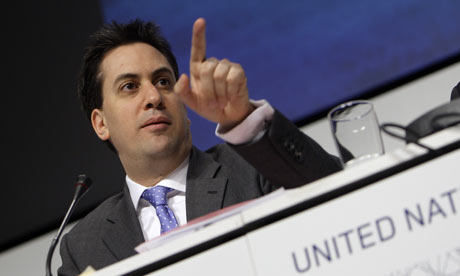If I ever see another singing, dancing, sloganising polar bear, I shall do my best to melt its ice-floe, says Geoffrey Lean.
Just how dumb – and self-indulgent – is this? On Wednesday morning the Copenhagen summit, widely seen as the last chance to stop global warming running out of control, stood – in boy wonder Ed Miliband's words – at "four minutes to midnight". Ministers from around the world had just arrived at the deadlocked talks in a last-minute attempt to rescue them. And green activists chose the moment to try to shut everything down.Thousands of protesters, organised by Climate Justice Action – a worldwide coalition of grass-roots groups – stormed the conference centre, blocking its entrance as they tussled with police and stopping delegates from entering. Gordon Brown, trapped inside, was prevented from starting his shuttle diplomacy with other heads of government to try to negotiate a deal.
Environmental groups inside the centre, meanwhile, shouted and banged drums to try to drown out proceedings. Indeed, many did their best to disrupt things throughout: staging sit-downs in the cavernous, crowded Bella Centre, in which the talks have been held – hindering negotiators from getting to key meetings – and holding noisy protests.
Now, don't get me wrong. Many green groups played really important parts both in the run-up to Copenhagen and at the conference itself. The World Wildlife Fund and Oxfam remained constructively on top of the proceedings. Greenpeace characteristically carried out its gadfly role, while the even more radical, virally spreading 350 campaign did much to mobilise pressure for tougher emissions reductions. And other, less well-known organisations – such as the unappetisingly named Stakeholder Forum and Institute for Governance and Sustainable Development – did patient, valuable work to try to get important issues that might otherwise have been neglected into the agreement.
But they were outweighed by thousands of activists who contributed nothing but obstruction. They were dubbed "policy tourists" by the more engaged groups, but that seems over-generous: they seemed mainly interested in having a good time and staging stunts for the cameras. If I ever see another singing, dancing, sloganising polar bear, I shall do my best to melt its ice-floe. And that goes for the climate-sceptic Ursus maritimus that turned up at one point, megaphone in paw, howling imprecations about the scientists who wrote the hacked and much-hyped emails.
In fairness, much of the blame lies with the Danish government and the UN Framework Convention on Climate Change, which organised the summit. In an attempt to be inclusive, they accredited 46,000 people in a centre that holds 15,000. Most came from non-governmental organisations (NGOs), ranging from serious institutes to industry lobbyists, as well as the policy tourists.
The rationale was that they would not all turn up at once – but enough did to create chaos. Huge queues snaked around the centre, with people waiting up to 10 hours to get in. Substantial figures such as John Prescott and Lord Stern, of the eponymous report, were among those left in the cold for hours.
Do them good to suffer like anyone else, you might say – but they had something to contribute, unlike the demonstrators inside. Ian Johnson – a former vice-president of the World Bank in charge of environmental issues, with vast experience of making difficult negotiations work – also queued for hours, only to be frogmarched out of the centre by security guards because the policy tourists had filled the place up.
Those who did get in found a centre so jammed up that it became dysfunctional, contributing to the bad-tempered atmosphere that bogged the talks down in fractious manoeuvring and points of order. Busy delegates had to wait for half an hour to get cold and indifferent food, progress was difficult, and the sheer press of people inhibited the chance corridor encounters that traditionally lubricate such negotiations.
But when the organisers tried to cut the number of NGO representatives to a far from ungenerous 1,000, you'd have thought from the outrage that they were sending tanks into Tiananmen Square. Fifty organisations – including Friends of the Earth, the World Development Movement, Cafod and Christian Aid – fumed at the "undemocratic"` and "draconian" measure.
The irritated authorities responded by cutting the numbers to just 300 … and suddenly the policy tourists were gone and the blessedly polar-bear-free centre started functioning. It may be no coincidence that that was also the first day – even closer to midnight – when any progress was made in the negotiations.
Canada is visited by an unwelcome jest
Danes are much the jolliest of the Scandinavians (which, admittedly, is not saying much) but, even so, there have not been many laughs in Copenhagen over the past two weeks. There has, though, been one successful hoax – and no, before you ask, I am not referring to the constant claims by extreme climate sceptics that the 200-year volume of science behind global warming adds up to the greatest con ever perpetrated.
The victims were the Canadians, widely excoriated as the most climate-unfriendly government in the industrialised world since the departure of George W Bush – not least for allowing their carbon dioxide emissions to rise by more than 20 per cent instead of cutting them as they agreed to do under the Kyoto Protocol; and for developing their vast tar sands to make the world’s dirtiest fuel.
Activists put out a hoax press release, supposedly from the Canadian government, announcing that it was reversing its position and taking on one of the world’s toughest reduction targets because “taking full responsibility for our emissions is just Canadian good sense”.
For good measure, it followed up with a fake video of a supposed Ugandan delegate welcoming the U-turn. The media was duly fooled, to everyone’s embarrassment.
The official response, when it came, was even stranger than the hoax. Canada’s environment minister Jim Prentice called the prank a “moral misfire” and denounced its “cruelty, hypocrisy and immorality”.
Poor lamb – your heart bleeds for him, doesn’t it?







![[Copenhagen conference]](http://s.wsj.net/public/resources/images/OB-FB985_1214co_D_20091214121817.jpg) Getty Images
Getty Images 




